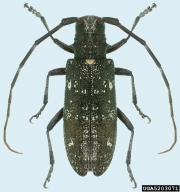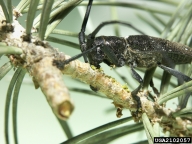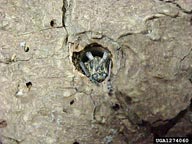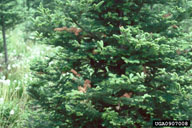Whitespotted sawyer
Monochamus scutellatus (Say) (Coleoptera: Cerambycidae)
Orientation to pest
Whitespotted sawyer, Monochamus scutellatus (Say), is a native North American borer that attacks dying or recently dead conifers that have dried out somewhat but have not been heavily attacked by other wood-feeding insects. There are two recognized subspecies, M. scutellatus scutellatus and M. scutellatus oregonensis. Females lay their eggs in slits chewed in the bark near branch scars or rough areas of bark. When eggs hatch, young larvae bore through the phloem into the cambium. Young larvae mine beneath the bark. Later instars tunnel toward the heartwood. Prior to pupation, the larva turns its tunnel toward the surface, where it pupates behind a chip plug. There is one generation per year in the northern part of its range and two in the southern portion. Logs left in the forest untended over a summer season are especially suitable for attack by this borer. This sawyer beetle is also able to vector the parasitic pinewood nematode, Bursaphelenchus xylophilus (Steiner and Buhrer) Nickle, which causes pine-wilt disease in Minnesota and Wisconsin. Damage to logs can be reduced by cutting timber in fall or winter and removing logs from woods before summer. Pulpwood logs can be partially protected by piling them in the shade or covering them with slash.
Hosts commonly attacked
The whitespotted sawyer attacks a variety of conifers but prefers eastern white pine (Pinus strobus L.). This beetle will also attack jack pine (Pinus banksiana Lamb.), red pine (Pinus resinosa Ait.), balsam fir (Abies balsamea [L.] Mill.), white spruce (Picea glauca (Moench) Voss), black spruce (Picea mariana (Mill.) B. S. P.), and red spruce (Picea rubens Sarg.). Tamarack (Larix laricina (DuRoi) K. Koch) occasionally serves as a host.
Distribution
Whitespotted sawyer is found in the United States, north of North Carolina and westward through the Great Lakes states, across Canada and north to Alaska.
Images of whitespotted sawyer
| Figure 1. Adult whitespotted sawyer, Monochamus scutellatus; right, adult feeding on twigs | Figure 2. Adult emergence hole (with head of adult visible) of whitespotted sawyer | Figure 3. Flagging of branches killed by adult feeding of whitespotted sawyer beetles | |
Important biological control agents related to this pest species
Natural enemies of whitespotted sawyer include tachinids in the genus Eutheresia and ichneumonids in the genera Rhyssa and Dolichomitus, but their actual influence on population levels of whitespotted sawyer is unknown.
Web links for information on whitespotted sawyer
- HPIPM Article on BugwoodWiki | http://wiki.bugwood.org
- Fact Sheet on ForestPests.org | Vermont Division of Forestry
- Forest Insect & Disease Leaflet 74 | USDA Forest Service
Articles
- Raske, A. G. 1973. Relationship between felling date and larval density of Monochamus scutellatus. Bi-monthly Research Notes 29 (4): 23-24.
- Wingfield, M. J. and R. A. Blanchette. 1983. The pine-wood nematode, Bursaphelenchus xylophilus, in Minnesota and Wisconsin: insect associates and transmission studies. Canadian Journal of Forest Research 13(6): 1068-1076.







